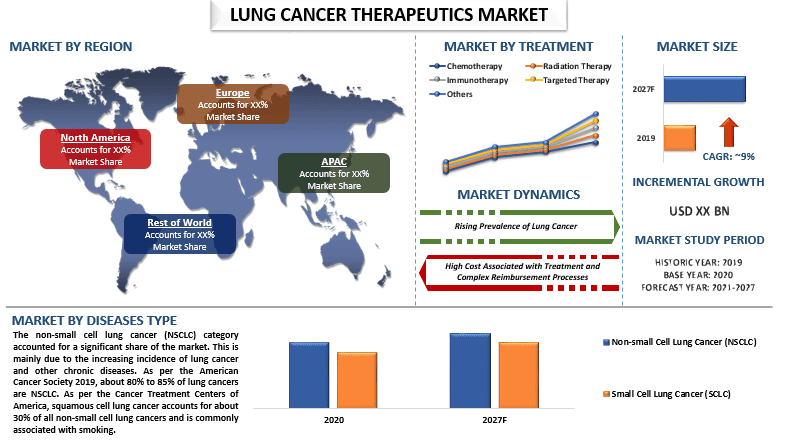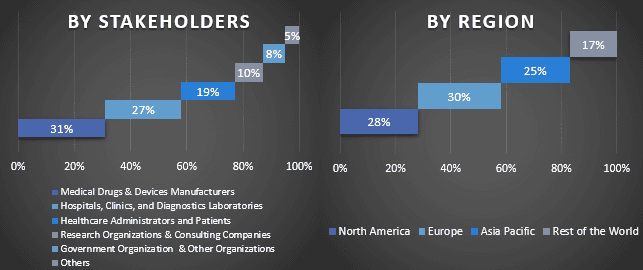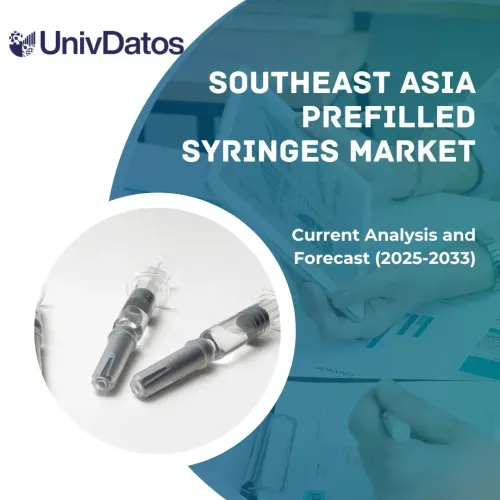- Home
- About Us
- Industry
- Services
- Reading
- Contact Us
Lung Cancer Therapeutics Market: Current Analysis and Forecast (2021-2027)
Emphasis on Disease Type (Non-Small Cell Lung Cancer (NSCLC) and Small Cell Lung Cancer (SCLC)); Treatment (Chemotherapy, Radiation Therapy, Immunotherapy, Targeted Therapy, and Others); Molecule Type (Small molecules and Biologics); Distribution Channel (Hospital Pharmacies, E-Commerce, Retail Pharmacies, and Others); and Region/Country

The global lung cancer therapeutics market is expected to register a CAGR of around 9% from 2021 to 2027. This can be mainly ascribed to the increase in cases of lung cancer owing to the high number of smokers population. Further, CDC has stated that lung cancer is one of the primary cancers which is still a leading cause of death and a health threat to millions worldwide. Additionally, unhealthy lifestyles and smoking habits have led to increased occurrence of lung cancer in younger demographics. According to CDC, more than 16 million Americans are living with a disease caused by smoking. Smoking also increases the risk of tuberculosis and problems with the immune system. Many therapies are available for the treatment of lung cancer, including chemotherapy, targeted therapy, surgery, and radiation therapy. Furthermore, lung cancer therapeutics enable the diagnosis and treatment of the same with the help of multiple systems.
AstraZeneca, Boehringer Ingelheim, Bristol-Myers Squibb Company, Eli Lilly and Company, F. Hoffmann-La Roche AG, Merck & Co, Pfizer Inc., Allergan Inc., Teva Pharmaceutical Industries Ltd., AbbVie, Inc are some of the key players in the market. Several M&As along with partnerships have been undertaken by these players to facilitate customers with hi-tech and innovative products/technologies.
Insights Presented in the Report
“Amongst Diseases Type, non-small cell lung cancer category accounted for the majority share in the market in 2020”
Based on disease type, the market is segmented into non-small cell lung cancer (NSCLC) and small cell lung cancer (SCLC). In 2020, the non-small cell lung cancer category dominated the market and is expected to maintain its dominance throughout the forecast period. This is mainly due to non-small cell lung cancer growing regularly. Non-small lung cancer is treated with the help of advanced therapeutics depending on the age and underlying conditions of the patient.
“Amongst Treatment, targeted therapy held a prominent share in the market”
Based on treatment, the market is segmented into chemotherapy, radiation therapy, immunotherapy, targeted therapy, and others. Among these, the targeted therapy category accounted for the major share of global lung cancer therapeutics. The main aim of targeted therapy is to concentrate the drug at the targeted site through passive or active targeting so that only a small amount of drug molecules can damage normal tissue.
“North America accounted for a major share in the market”
North America accounted for a major share of the lung cancer therapeutics market. The major contributors to the growth of this market are US and Canada. This is mainly due to the increasing incidence of cancer which causes death in countries like the U.S. and Canada. The growing lung cancer is more common in men than women, particularly African American men. The chance of getting lung cancer increases with age, and, of course, a smoking history significantly contributed to the considerable growth of the state in the U.S. lung cancer therapeutics market. The increase in awareness about lung cancer therapeutics, health screening, and the rise in the patient base suffering from cancer in the U.S. is expected to drive the market in the region. According to the American Society of Clinical Oncology, lung cancer is the second most common cancer and approximately 235,760 adults (119,100 men and 116,660 women) in the United States will be diagnosed with lung cancer by the end of 2021. Furthermore, many medical and pharmaceutical companies are headquartered in the region, which is now focusing on research and development and clinical research activity for the treatment of cancer and various developmental strategies adopted by the regional market will drive market growth.
Reasons to buy this report:
- The study includes market sizing and forecasting analysis validated by authenticated key industry experts.
- The report presents a quick review of overall industry performance at one glance.
- The report covers an in-depth analysis of prominent industry peers with a primary focus on key business financials, product portfolio, expansion strategies, and recent developments.
- Detailed examination of drivers, restraints, key trends, and opportunities prevailing in the industry.
- The study comprehensively covers the market across different segments.
- Deep dive regional level analysis of the industry.
Customization Options:
The global lung cancer therapeutics market can further be customized as per the requirement or any other market segment. Besides this, UMI understands that you may have your own business needs, hence feel free to connect with us to get a report that completely suits your requirements.
Table of Content
Research Methodology for the Global Lung Cancer Therapeutics Market Analysis (2021-2027)
Analyzing the historical market, estimation of the current market, and forecasting the future market of the global lung cancer therapeutics market were the three major steps undertaken to create and analyze the adoption of lung cancer therapeutics in major regions globally. Exhaustive secondary research was conducted to collect the historical market numbers and estimate the current market size. Secondly, to validate these insights, numerous findings and assumptions were taken into consideration. Moreover, exhaustive primary interviews were also conducted, with industry experts across the value chain of the global lung cancer therapeutics market. Post assumption and validation of market numbers through primary interviews, we employed a top-down/bottom-up approach to forecasting the complete market size. Thereafter, market breakdown and data triangulation methods were adopted to estimate and analyze the market size of segments and sub-segments of the industry pertains to. Detailed methodology is explained below:
Analysis of Historical Market Size
Step 1: In-Depth Study of Secondary Sources:
Detail secondary study was conducted to obtain the historical market size of the lung cancer therapeutics market through company internal sources such as annual reports & financial statements, performance presentations, press releases, etc., and external sources including journals, news & articles, government publications, competitor publications, sector reports, third-party database, and other credible publications.
Step 2: Market Segmentation:
After obtaining the historical market size of the lung cancer therapeutics market, we conducted a detailed secondary analysis to gather historical market insights and share for different segments & sub-segments for major regions. Major segments are included in the report as disease type, treatment, molecule type, distribution channel, and region. Further country-level analyses were conducted to evaluate the overall adoption of testing models in that region.
Step 3: Factor Analysis:
After acquiring the historical market size of different segments and sub-segments, we conducted a detailed factor analysis to estimate the current market size of the lung cancer therapeutics market. Further, we conducted factor analysis using dependent and independent variables such as disease type, treatment, molecule type, distribution channel, and region of lung cancer therapeutics. A thorough analysis was conducted for demand and supply-side scenarios considering top partnerships, mergers and acquisitions, business expansion, and product launches in the Lung cancer therapeutics market sector across the globe.
Current Market Size Estimate & Forecast
Current Market Sizing: Based on actionable insights from the above 3 steps, we arrived at the current market size, key players in the global lung cancer therapeutics market, and market shares of the segments. All the required percentage shares split, and market breakdowns were determined using the above-mentioned secondary approach and were verified through primary interviews.
Estimation & Forecasting: For market estimation and forecast, weights were assigned to different factors including drivers & trends, restraints, and opportunities available for the stakeholders. After analyzing these factors, relevant forecasting techniques i.e., the top-down/bottom-up approach were applied to arrive at the market forecast about 2027 for different segments and sub-segments across the major markets globally. The research methodology adopted to estimate the market size encompasses:
- The industry’s market size, in terms of revenue (USD) and the adoption rate of lung cancer therapeutics market across the major markets domestically
- All percentage shares, splits, and breakdowns of market segments and sub-segments
- Key players in the global lung cancer therapeutics market in terms of solutions offered. Also, the growth strategies adopted by these players to compete in the fast-growing market
Market Size and Share Validation
Primary Research: In-depth interviews were conducted with the Key Opinion Leaders (KOLs) including Top Level Executives (CXO/VPs, Sales Head, Marketing Head, Operational Head, Regional Head, Country Head, etc.) across major regions. Primary research findings were then summarized, and statistical analysis was performed to prove the stated hypothesis. Inputs from primary research were consolidated with secondary findings, hence turning information into actionable insights.
Split of Primary Participants in Different Regions

Market Engineering
The data triangulation technique was employed to complete the overall market estimation and to arrive at precise statistical numbers for each segment and sub-segment of the global lung cancer therapeutics market. Data was split into several segments & sub-segments post studying various parameters and trends in the areas of disease type, treatment, molecule type, distribution channel, and region in the global lung cancer therapeutics market.
The main objective of the global lung cancer therapeutics Market Study
The current & future market trends of the global lung cancer therapeutics market were pinpointed in the study. Investors can gain strategic insights to base their discretion for investments on the qualitative and quantitative analysis performed in the study. Current and future market trends determined the overall attractiveness of the market at a regional level, providing a platform for the industrial participant to exploit the untapped market to benefit from a first-mover advantage. Other quantitative goals of the studies include:
- Analyze the current and forecast market size of the lung cancer therapeutics market in terms of value (USD). Also, analyze the current and forecast market size of different segments and sub-segments
- Segments in the study include areas of disease type, treatment, molecule type, distribution channel, and region.
- Define and analysis of the regulatory framework for the lung cancer therapeutics market industry.
- Analyze the value chain involved with the presence of various intermediaries, along with analyzing customer and competitor behaviors of the industry.
- Analyze the current and forecast market size of the lung cancer therapeutics market for the major region.
- Major countries of regions studied in the report include North America, Europe, Asia Pacific, and the Rest of the world.
- Company profiles of the lung cancer therapeutics market and the growth strategies adopted by the market players to sustain in the fast-growing market
- Deep dive regional level analysis of the industry
Related Reports
Customers who bought this item also bought










